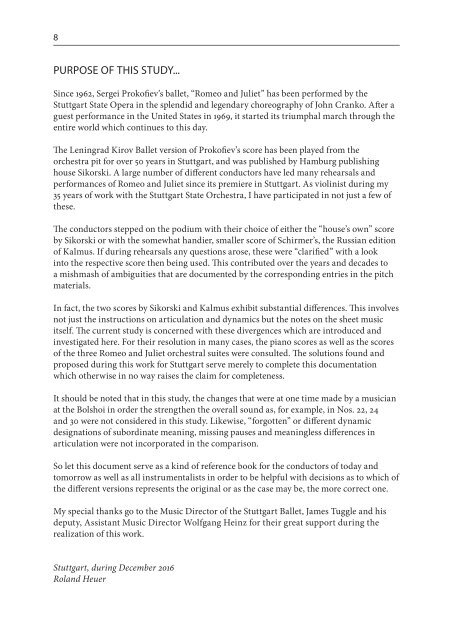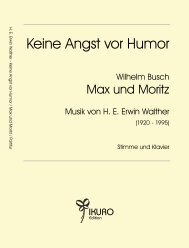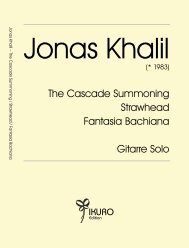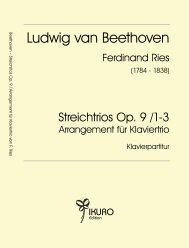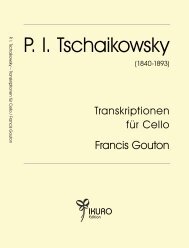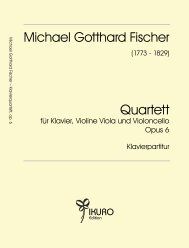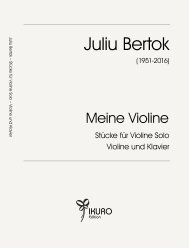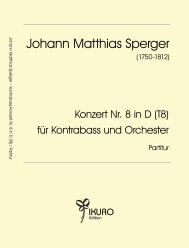161216 "Es war die Nachtigall, und nicht die Lerche..." (Auszug)
Sergei Prokofieffs Ballettmusik zu Romeo und Julia – Eine analytische Untersuchung der Partituren von Schirmer (Kalmus) und Sikorski im Spiegel der drei Orchestersuiten und der Klavierauszüge
Sergei Prokofieffs Ballettmusik zu Romeo und Julia – Eine analytische Untersuchung der Partituren von Schirmer (Kalmus) und Sikorski im Spiegel der drei Orchestersuiten und der Klavierauszüge
Sie wollen auch ein ePaper? Erhöhen Sie die Reichweite Ihrer Titel.
YUMPU macht aus Druck-PDFs automatisch weboptimierte ePaper, die Google liebt.
8<br />
PURPOSE OF THIS STUDY...<br />
Since 1962, Sergei Prokofiev’s ballet, “Romeo and Juliet” has been performed by the<br />
Stuttgart State Opera in the splendid and legendary choreography of John Cranko. After a<br />
guest performance in the United States in 1969, it started its triumphal march through the<br />
entire world which continues to this day.<br />
The Leningrad Kirov Ballet version of Prokofiev’s score has been played from the<br />
orchestra pit for over 50 years in Stuttgart, and was published by Hamburg publishing<br />
house Sikorski. A large number of different conductors have led many rehearsals and<br />
performances of Romeo and Juliet since its premiere in Stuttgart. As violinist during my<br />
35 years of work with the Stuttgart State Orchestra, I have participated in not just a few of<br />
these.<br />
The conductors stepped on the podium with their choice of either the “house’s own” score<br />
by Sikorski or with the somewhat han<strong>die</strong>r, smaller score of Schirmer’s, the Russian edition<br />
of Kalmus. If during rehearsals any questions arose, these were “clarified” with a look<br />
into the respective score then being used. This contributed over the years and decades to<br />
a mishmash of ambiguities that are documented by the corresponding entries in the pitch<br />
materials.<br />
In fact, the two scores by Sikorski and Kalmus exhibit substantial differences. This involves<br />
not just the instructions on articulation and dynamics but the notes on the sheet music<br />
itself. The current study is concerned with these divergences which are introduced and<br />
investigated here. For their resolution in many cases, the piano scores as well as the scores<br />
of the three Romeo and Juliet orchestral suites were consulted. The solutions fo<strong>und</strong> and<br />
proposed during this work for Stuttgart serve merely to complete this documentation<br />
which otherwise in no way raises the claim for completeness.<br />
It should be noted that in this study, the changes that were at one time made by a musician<br />
at the Bolshoi in order the strengthen the overall so<strong>und</strong> as, for example, in Nos. 22, 24<br />
and 30 were not considered in this study. Likewise, “forgotten” or different dynamic<br />
designations of subordinate meaning, missing pauses and meaningless differences in<br />
articulation were not incorporated in the comparison.<br />
So let this document serve as a kind of reference book for the conductors of today and<br />
tomorrow as well as all instrumentalists in order to be helpful with decisions as to which of<br />
the different versions represents the original or as the case may be, the more correct one.<br />
My special thanks go to the Music Director of the Stuttgart Ballet, James Tuggle and his<br />
deputy, Assistant Music Director Wolfgang Heinz for their great support during the<br />
realization of this work.<br />
Stuttgart, during December 2016<br />
Roland Heuer


